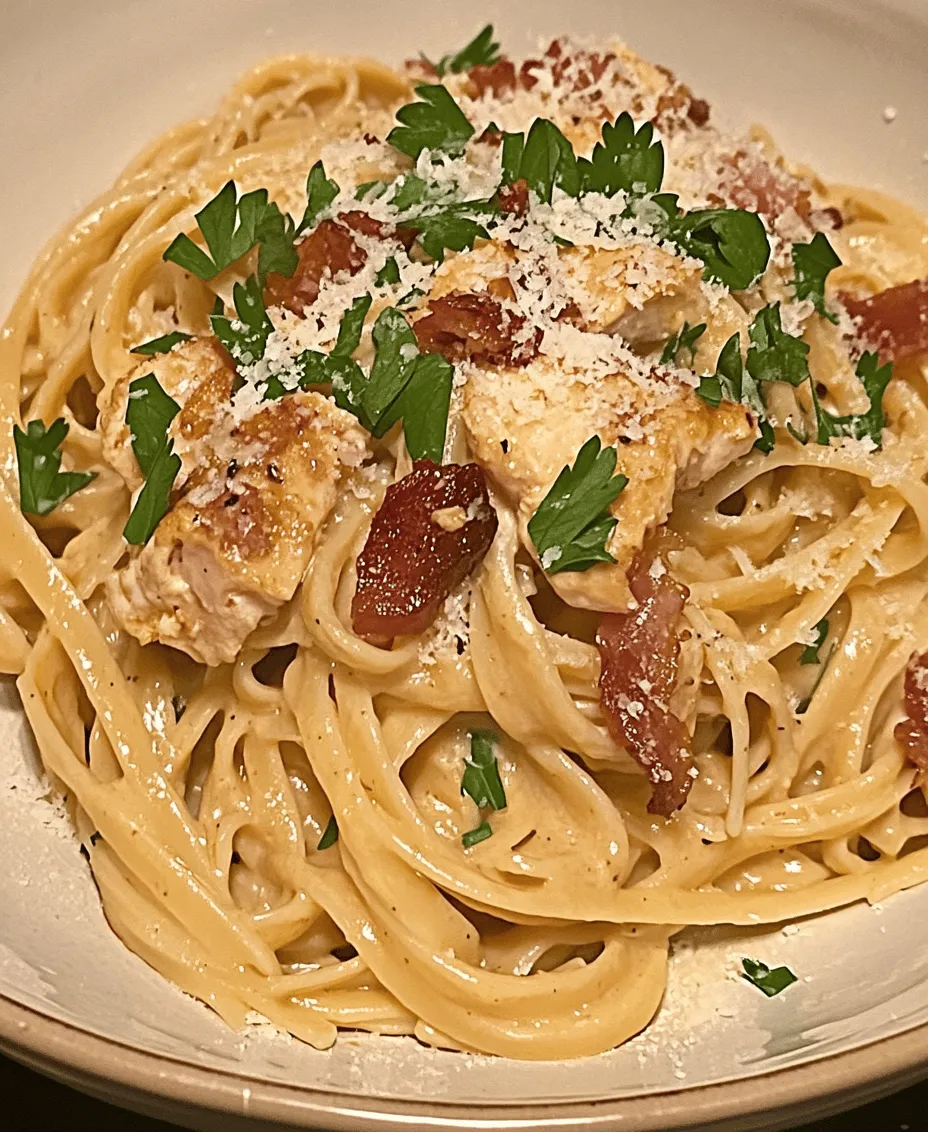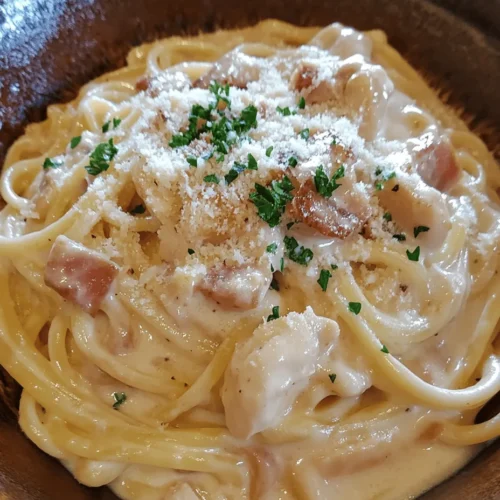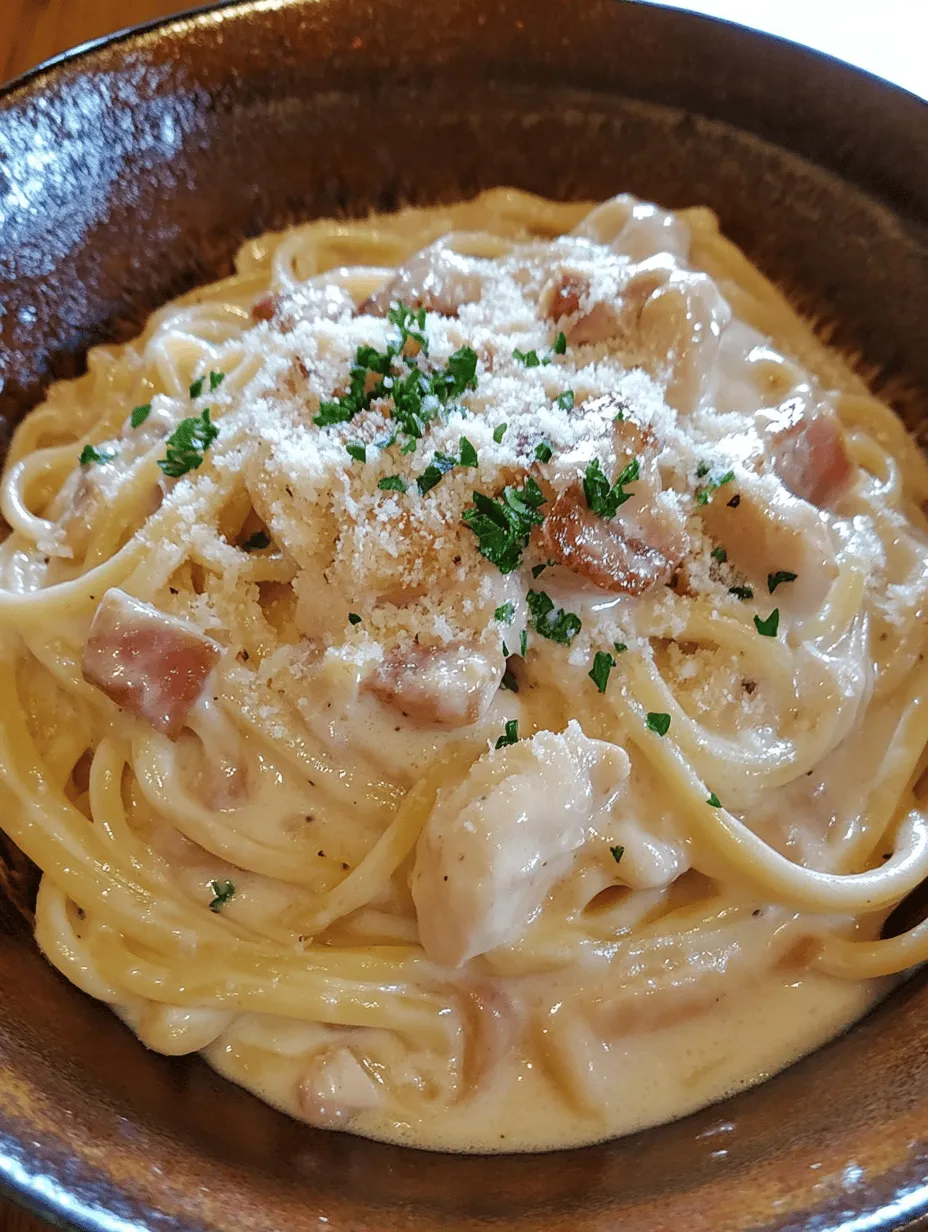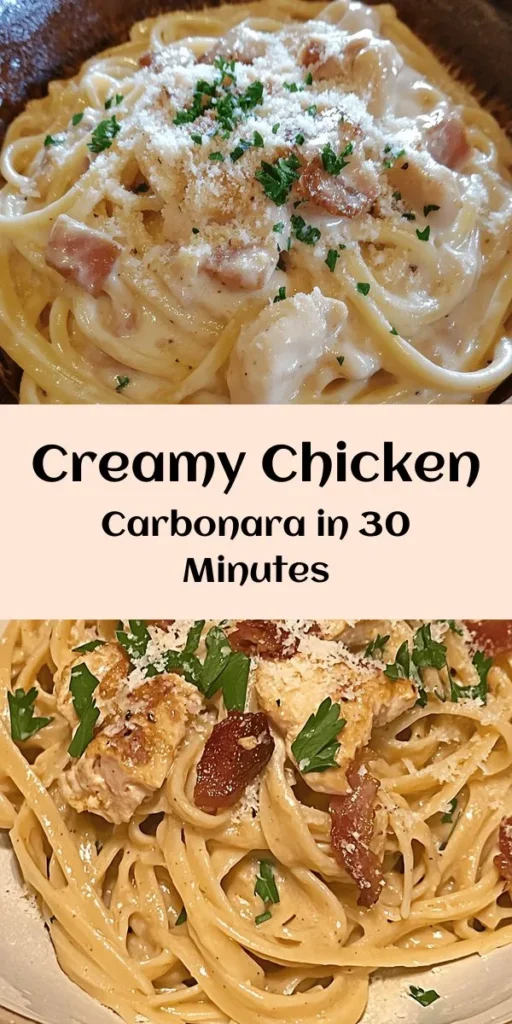Introduction
When it comes to Italian cuisine, few dishes evoke the same level of comfort and satisfaction as Carbonara. This iconic pasta dish hails from Rome and is deeply rooted in the culinary traditions of Italy. Traditionally made with just a handful of ingredients, including eggs, cheese, cured pork, and black pepper, Carbonara is a celebration of simplicity and flavor. Its creamy texture and rich taste have made it a beloved classic, not only in Italy but around the world.
In this article, we will explore a delightful twist on the traditional recipe: Chicken Carbonara. By adding tender, juicy chicken to the mix, we elevate this comforting dish to new heights, making it a hearty meal that’s perfect for any occasion. Whether you’re preparing a weeknight dinner or hosting a special gathering, Chicken Carbonara is sure to impress. Plus, the straightforward nature of this recipe makes it accessible for home cooks of all skill levels, allowing anyone to create an Italian masterpiece in their own kitchen.
Understanding Carbonara
To truly appreciate Chicken Carbonara, it’s essential to understand the roots of its traditional counterpart. Classic Carbonara originated in the mid-20th century and is characterized by its creamy sauce made from egg yolks and Pecorino Romano cheese. The dish is typically prepared with spaghetti or rigatoni, which serves as the perfect vehicle for the sauce. The addition of guanciale—a type of Italian cured meat made from pork cheek—adds depth and flavor that is truly unique to Carbonara.
While traditionalists may argue about the “authentic” way to make Carbonara, variations have emerged over the years, each with its unique flair. One of the most popular modifications is the inclusion of chicken, which not only adds protein but also enhances the dish’s heartiness. This adaptation has gained traction across various culinary landscapes, making Chicken Carbonara a staple in many households.
The popularity of Chicken Carbonara can be attributed to its versatility and comforting qualities. The creamy sauce clings to the pasta, while the chicken adds a satisfying bite. Additionally, the dish is a canvas for creativity—chefs and home cooks alike can experiment with different ingredients, such as vegetables or spices, to create their own version. As a result, Chicken Carbonara has become a beloved dish in modern cuisine, offering a delightful twist on a classic that continues to warm hearts and bellies.
Key Ingredients for Your Chicken Carbonara
Creating the perfect Chicken Carbonara starts with selecting high-quality ingredients. Each component plays a crucial role in achieving the rich, creamy texture and robust flavors that define this dish. Here’s a detailed look at the essential ingredients you will need:
Fettuccine or Spaghetti
The choice of pasta is fundamental to the Carbonara experience. While spaghetti is the traditional option, fettuccine—broad, flat noodles—provides a delightful texture that holds the sauce beautifully. Whichever you choose, ensure that the pasta is cooked al dente, as it will continue to cook slightly when combined with the sauce.
Boneless, Skinless Chicken Breasts
For our Chicken Carbonara, boneless, skinless chicken breasts are the protein of choice. They are lean, versatile, and cook quickly, making them ideal for weeknight meals. When cooked properly, they remain juicy and tender, perfectly complementing the creamy sauce.
Pancetta or Bacon
To introduce a savory depth to the dish, pancetta or bacon is essential. Pancetta, an Italian cured meat, offers a rich, slightly sweet flavor that enhances the overall profile of the Carbonara. If you can’t find pancetta, good-quality bacon will work just as well, imparting its own delicious smoky notes.
Eggs
Eggs are the heart of the Carbonara sauce. They provide the creamy consistency that binds the dish together. Using fresh eggs will yield the best results, as they contribute to the richness of the sauce when combined with the cheese.
Parmesan Cheese
Parmesan cheese is a must-have ingredient in Chicken Carbonara. It not only elevates the flavor profile of the dish but also helps to thicken the sauce. For the best taste, use freshly grated Parmesan, as pre-packaged versions often lack the same depth of flavor.
Heavy Cream
While traditional Carbonara does not include cream, many modern variations—like our Chicken Carbonara—incorporate heavy cream. This addition enhances the dish’s richness and ensures a silky texture that coats the pasta beautifully.
Garlic
A few cloves of minced garlic infuse the dish with aromatic qualities that enhance its overall flavor. Garlic pairs perfectly with the chicken and adds depth without overpowering the other ingredients.
Olive Oil
A high-quality extra virgin olive oil is essential for sautéing the chicken and pancetta. The oil not only helps in cooking but also adds a subtle fruitiness that complements the other flavors.
Fresh Parsley
To finish the dish, a sprinkle of freshly chopped parsley adds a touch of color and brightness. This garnish not only enhances the presentation but also provides a fresh contrast to the rich sauce.
Importance of Using High-Quality Ingredients
When it comes to making Chicken Carbonara, the quality of your ingredients can significantly impact the final result. Fresh, high-quality ingredients will yield a dish that is flavorful and satisfying, while subpar ingredients can lead to a lackluster meal. Always opt for fresh produce, good-quality meats, and authentic cheese when possible. By investing in your ingredients, you ensure that your Chicken Carbonara will be a true culinary delight.
Step-by-Step Cooking Instructions
Now that you have your ingredients ready, it’s time to dive into the cooking process. Below are the initial steps to get you started on your journey to creating the best Chicken Carbonara.
Cooking the Pasta
1. Boil the Water: Fill a large pot with water and bring it to a rolling boil. The amount of water should be sufficient to allow the pasta to move freely as it cooks.
2. Salt the Water: Once the water is boiling, generously salt it. This is a crucial step, as it enhances the pasta’s flavor. A good rule of thumb is to add about 1-2 tablespoons of salt to every gallon of water.
3. Add the Pasta: Carefully add your fettuccine or spaghetti to the boiling water. Stir the pasta occasionally to prevent it from sticking together.
4. Cook to Al Dente: Refer to the package instructions for the recommended cooking time, but start checking for doneness a minute or two before the time is up. You want the pasta to be al dente—firm to the bite but not hard.
5. Reserve Pasta Water: Before draining the pasta, reserve about a cup of the starchy pasta water. This water will be invaluable for achieving the desired sauce consistency later on.
6. Drain the Pasta: Once the pasta is cooked to perfection, drain it in a colander. Do not rinse the pasta, as this will wash away the starch that helps the sauce adhere to it.
With the pasta cooked, you’re well on your way to preparing a delicious Chicken Carbonara. In the next section, we will cover the remaining steps, including how to cook the chicken, prepare the sauce, and combine everything for a creamy, satisfying meal. Stay tuned as we continue to unravel the secrets to making this classic Italian dish a family favorite.

Sautéing the Chicken
To achieve perfectly cooked, golden-brown chicken for your Chicken Carbonara, start with boneless, skinless chicken breasts or thighs, as they provide a tender and juicy result. Before cooking, take the time to pat the chicken dry with paper towels; this step ensures a nice sear when it hits the hot pan.
Techniques for Achieving Perfectly Cooked Chicken:
1. Preheat the Pan: Heat a large skillet over medium-high heat and add a tablespoon of olive oil. You want the oil to shimmer but not smoke, indicating that it’s hot enough to sear the chicken.
2. Cook in Batches: If your skillet isn’t large enough to accommodate all the chicken at once without crowding, cook in batches. This prevents steaming and allows for that coveted golden crust.
3. Seasoning Tips: Season the chicken liberally with salt and freshly cracked black pepper before placing it in the pan. For an added flavor boost, consider sprinkling some garlic powder or Italian herbs, such as oregano and thyme, which complement the dish beautifully.
Cook the chicken for about 4-5 minutes per side, depending on the thickness. It should reach an internal temperature of 165°F (75°C). Once cooked, remove the chicken from the skillet and let it rest for a few minutes before slicing it into bite-sized pieces. This resting time allows the juices to redistribute, ensuring moist chicken in your final dish.
Cooking Pancetta or Bacon
The next star ingredient in your Chicken Carbonara is the pancetta or bacon, which adds a hearty, savory depth to the dish.
Best Practices for Rendering Fat:
1. Start with a Cold Pan: Place your diced pancetta or bacon in a cold skillet and turn the heat to medium. This technique allows the fat to render slowly, resulting in crispy, flavorful bits without burning.
2. Stir Occasionally: Stir the meat occasionally to ensure even cooking. The goal is to achieve a crispy texture without overcooking.
Timing Garlic Addition for Maximum Flavor:
Once the pancetta or bacon is crispy and golden, it’s time to add minced garlic. Timing is crucial here—add the garlic to the pan about 30 seconds to 1 minute before removing it from the heat. This technique allows the garlic to infuse its flavor into the fat without burning, which can lead to a bitter taste. Stir the garlic until fragrant, about 30 seconds, before proceeding to the next step.
Making the Sauce
The creamy sauce is what truly elevates your Chicken Carbonara, and achieving the perfect consistency is essential.
Emphasis on Whisking Eggs, Cream, and Cheese:
In a mixing bowl, whisk together 3 large eggs, 1 cup of heavy cream, and 1 cup of freshly grated Parmesan cheese until smooth. The key to a luscious sauce is ensuring the eggs are well combined with the cream and cheese. This mixture will create the creamy base that clings beautifully to the pasta and chicken.
Tips on Seasoning the Sauce Properly:
Before adding the sauce to the pasta, season it lightly with salt and freshly cracked black pepper. Remember that the cheese will add saltiness too, so err on the side of caution. You can always adjust the seasoning later.
Combining Ingredients
Combining the pasta, chicken, and sauce requires attention to temperature to avoid scrambling the eggs.
Importance of Low Heat:
After cooking the pasta until al dente, reserve about a cup of the starchy pasta water before draining. In the same skillet used for the chicken and pancetta, reduce the heat to low. This low temperature is crucial when adding the egg mixture to ensure a creamy sauce rather than scrambled eggs.
Techniques for Ensuring Even Coating:
1. Combine Ingredients Gently: Begin by adding the drained pasta to the skillet, along with the chicken and pancetta. Toss gently to combine.
2. Incorporate the Sauce: Slowly pour the egg and cream mixture over the pasta while continuously tossing. The heat from the pasta will cook the eggs gently, creating a silky sauce. If the sauce seems too thick, gradually add reserved pasta water until you reach the desired consistency.
Serving Suggestions
Presentation can make a world of difference when serving Chicken Carbonara.
Presentation Tips for a Restaurant-Quality Look:
– Serve the Chicken Carbonara in warmed bowls or plates to keep it hot.
– Garnish with freshly chopped parsley or basil for a pop of color and freshness.
– A sprinkling of extra grated Parmesan cheese on top adds both flavor and visual appeal.
Suggested Pairings:
Pair your Chicken Carbonara with a crisp white wine, such as Pinot Grigio or Chardonnay, which complements the creamy sauce beautifully. For side dishes, consider a simple arugula salad dressed with lemon vinaigrette or garlic bread to round out the meal.
Nutritional Information
For those mindful of dietary choices, here’s a breakdown of the nutritional information per serving (assuming a recipe serves four):
– Calories: Approximately 600-700 kcal
– Protein: 35-40 grams
– Fat: 30-35 grams
– Carbohydrates: 50-60 grams
Discussion of Nutritional Benefits:
Chicken Carbonara is a hearty dish that provides a balance of protein from the chicken and cheese, along with carbohydrates from the pasta. For those looking to modify the recipe for dietary preferences, consider using gluten-free pasta or substituting the heavy cream with a plant-based alternative to make it dairy-free.
Why This Recipe Stands Out
What sets this Chicken Carbonara apart from traditional recipes is its perfect balance of flavors and textures.
Unique Aspects:
– The inclusion of both chicken and pancetta offers a delightful contrast of savory flavors that elevate the dish beyond standard carbonara.
– The creamy sauce, enriched with freshly grated cheese, results in a luxurious mouthfeel that is both comforting and sophisticated.
Ease of Preparation:
This recipe is designed to be simple, making it an excellent choice for weeknight dinners. With straightforward steps and minimal ingredients, you can have a restaurant-quality meal on the table in under 30 minutes.
Conclusion
Making Chicken Carbonara at home is not just about the cooking; it’s about creating a dish that brings joy to your dining experience. The creamy sauce, tender chicken, and crispy pancetta come together to create a truly delicious meal that can impress family and friends alike.
As you experiment with this recipe, don’t hesitate to make it your own by adding seasonal vegetables or adjusting the seasonings to suit your taste. Incorporate this Chicken Carbonara into your regular meal rotations, and enjoy the delight that comes from preparing and sharing a comforting, homemade dish with those you love. Whether for a special occasion or a casual weeknight dinner, this recipe promises to be a favorite at your table.



